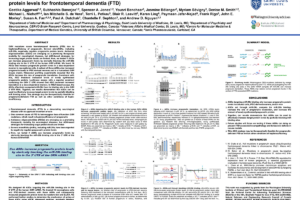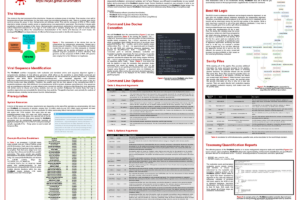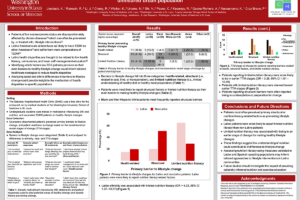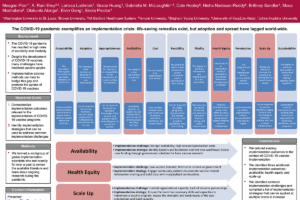2022 ICTS Symposium Posters
1. Characterizing the Genetic Factors Driving Rheumatoid Arthritis Inflammatory Interactions Using an SF-Chondrocyte Co-Culture Model
Introduction: Rheumatoid arthritis (RA) is an autoimmune joint-debilitating disease caused by genetic and environmental factors and affects more than 1 million Americans today. Studies have characterized several mechanisms for RA onset, identifying cytokines like IL-1, IL-2, and IL-6, as well as different receptors, as important in guiding the degrading cellular interactions in the articular microenvironment. […]
2. PET Imaging Cardiac Inflammation in CD36-deficient Individuals
Introduction: Our study will assess myocardial inflammation in individuals with dysfunctional lipid metabolism using a novel non-invasive positron emission tomography (PET) imaging approach. Fatty acid (FA) translocase CD36 regulates myocardial FA uptake, remodeling and inflammation. CD36 deletion in rodents associates with atrioventricular block and bradycardia; and risk of sudden death following prolonged fasting. In humans, […]
3. Assessment of CCR2 PET for Abdominal Aortic Aneurysm Rupture Prediction and Determination of Treatment Response
Introduction: Abdominal aortic aneurysms (AAA) are a life-threatening degenerative vascular disease without any effective medical therapy or imaging approach to predict the risk of rupture. AAAs occur later in life and are especially prevalent in men over the age of 65, but are more likely to rupture in women. Previously, we evaluated the efficiency of […]
4. Immunologic Response to Ivermectin Treatment of Loiasis
Introduction: Loiasis related post-ivermectin (IVM) adverse events (AEs) hinder lymphatic filariasis (LF)/onchocerciasis elimination in co-endemic areas. Findings from LF suggest that post-IVM AEs might be the result of immune responses to filarial or Wolbachia antigens released by dying microfilariae (Mf). The aim of this study was to determine whether IVM treatment of loiasis, devoid of […]
5. Integrative Analysis of DNA Methylation and RNA-seq Data for Biomarker Detection of Endometriosis
Introduction: Endometriosis, a complex and common gynecological disorder affecting 5-10% of reproductive-age women, is characterized by the growth of endometrial tissues outside of the uterine cavity. About 176 million women worldwide suffer from endometriosis. The current diagnostic process is laparoscopy, which is a risk-associated and costly invasive procedure. On average it takes 10 years to […]
6. Antithrombogenic Sutureless Vaso-Lock for Vascular Anastomosis
Introduction: Micro- and macrovascular anastomoses involve suturing together of blood vessels, which is a critical foundational surgical skill. However, it is costly, time-consuming, and prone to complications. Our team has created a unique anastomotic device, Vaso-Lock, as a sutureless coupler. Vaso-Lock is intraluminal, holding free vascular ends together with traction by anchors. In terms of […]
7. Developing Antisense Oligonucleotides Targeting MiR-29b Binding Site to Increase Progranulin Protein Levels for Frontotemporal Dementia
Introduction: Frontotemporal dementia (FTD) is a devastating neurological disease with no approved treatment or cure. One common cause of FTD is heterozygous loss-of-function GRN mutations, which result in progranulin haploinsufficiency. Antisense oligonucleotides (ASOs) are emerging as a promising therapeutic modality for neurological diseases, but ASO-based strategies for increasing target protein levels are limited. Several microRNAs […]
8. Development of an HPLC-based Method for the Separation of Transferrin Forms in Murine Serum
Introduction: Transferrin (Tf) is the primary iron binding protein in serum. It has two homologous lobes, N and C, that can each bind one iron molecule. Thus, Tf exists in four forms, apo-, monoferric N, monoferric C and holo-Tf. At physiologic Tf saturations, the monoferric Tfs are the predominant forms. Using mice genetically engineered to […]
9. Combined Inhibition of Myostatin and Activin A Enhances Femoral Microarchitecture and Strength in a Type I/IV Osteogenesis Imperfecta Mouse Model
Introduction: Current therapeutics for osteogenesis imperfecta (OI), a heritable connective tissue disorder characterized by skeletal fragility and impaired bone cell function, are limited to bisphosphonates. Soluble activin receptor type IIB (sActRIIB) decoy molecules, which bind transforming growth factor-β (TGF-β) ligands, including myostatin and activin A, have increased skeletal bone properties in murine models of OI, […]
10. Microgel Fabrication for Sustained Delivery of PRP to Treat Osteoarthritis
Introduction: Osteoarthritis (OA) is a debilitating joint disease that affects 50+ million American adults. Current treatment options are not optimal. Platelet-rich plasma (PRP) is a promising option. However, when PRP is delivered intra-articularly, it is rapidly cleared from the joint, diminishing treatment efficacy. We hypothesize that a delivery vehicle that can sustain PRP release will […]
11. Extracellular Vesicles from Inflammation-primed Adipose Stem Cells Improve Tendon Healing Through Restoring Balanced Response Following Tendon Injury and Repair
Introduction: Tendon injuries are among the most common and challenging orthopedic conditions. Many patients suffer from long-term pain and reduced function primarily due to an imbalanced healing response with excessive inflammation and inadequate regeneration. We found that extracellular vesicles produced by inflammation-primed adipose stem cells (iEV) can attenuate inflammation. It remains to be determined if […]
12. A Genome-wide Assessment of Non-coding Risk Variants in Cerebral Palsy
Introduction: Cerebral palsy (CP) is the most common physical disability in childhood characterized by irreversible, non-progressive central motor dysfunction. Genetic factors, and environmental insults such as prematurity and hypoxia-ischemia, can contribute to CP. However, significant gaps in our knowledge of the genetic basis of CP impede advances in preventive, diagnostic, and therapeutic measures. We recently […]
13. Comparison of Metagenomic Sequencing and the NanoString nCounter Analysis System for Characterization of Bacterial and Viral Communities in Vaginal Samples
Introduction: DNA sequencing assays have been used to characterize the vaginal microbiome and identify associations with reproductive outcomes. These assays are useful but can be prohibitively expensive and time consuming. The purpose of this study was to demonstrate the utility of the NanoString nCounter platform, a more efficient assay compared to sequencing, for characterization of […]
14. ViroMatch: A Computational Pipeline for Detection of Viral Reads from Complex Metagenomic Data
Introduction: Next-generation sequencing (NGS) allows the comprehensive characterization of the virome and discovery of novel viruses, as it enables culture-independent, agnostic assessment of viral nucleic acid within a sample. We have produced software in the form of an automated pipeline, ViroMatch, that takes raw NGS sequencing reads as input and performs read quantification and associated […]
15. Development of a Neuronavigation-guided Sonobiopsy Device for Glioblastoma Patients
Introduction: Focused ultrasound (FUS)-enabled liquid biopsy (sonobiopsy) is an emerging technique for the noninvasive and spatial-temporally controlled diagnosis of brain cancer by inducing blood-brain barrier (BBB) disruption to release brain tumor-specific biomarkers into the blood circulation. The feasibility, safety, and efficacy of sonobiopsy were demonstrated in both small and large animal models using magnetic resonance-guided […]
16. Pre-infusion Neurofilament Light Chain (NfL) Levels Predict Immune Effector Cell-associated Neurotoxicity Syndrome (ICANS)
Introduction: Neurological side effects after chimeric antigen receptor-modified (CAR) T cell therapy, termed immune effector cell-associated neurotoxicity syndrome (ICANS), are common and potentially devastating. We previously demonstrated that pre-infusion plasma neurofilament light chain (NfL), a well-established marker neurodegeneration, may predict subsequent development of ICANS in a small, single-center cohort. This larger, multicenter study compares pre-infusion […]
17. Effectiveness, Safety, and Tolerability of Different Estradiol Replacement Therapy Presentations in Transgender Females
Introduction: A typical regimen for transgender females includes estrogen to provide feminizing effects in conjunction antiandrogens. There is no data to indicate if a single daily dose vs divided daily doses vs continuous subcutaneous dosing of estradiol is more effective at suppressing endogenous testosterone production. The lack of research on gender affirming hormone therapy represents […]
18. Biological and Chemical Characterization of Aerosols Emitted During Dental Procedures in Real World Settings
Introduction: The composition of real world dental aerosols remained poorly understood. Previous studies have used in vitro experimental designs and/or indirect measures to evaluate bacteria and viruses from dental splatter. However, these findings may overestimate the occupational health risks for dental healthcare personnel (DHCP). The purpose if this study is to directly measure dental aerosol […]
19. Musculoskeletal Impairments Among Women with Urinary Urgency/Frequency
Introduction: Urgency and frequency are common lower urinary tract symptoms (UFLUTS) in women. There is limited evidence to guide physical therapist-led treatment. The focus of this project was to understand how pelvic floor muscle (PFM) strength and endurance, PFM mobility, and hip muscle strength differ between women with and without UFLUTS. Methods: Women with (n=21) […]
20. Coming Up with a COVID (Cure?): Using eConsent and National Recruitment in a Fully-Remote Clinical Trial
Introduction: The STOP COVID Trials were innovative, fully-remote randomized controlled trials of fluvoxamine (a sigma1 receptor agonist with anti-inflammatory properties) vs placebo for treatment of outpatients with early COVID-19 who were self-isolating at home. Methods: The trials used eConsent and an electronic data capture system with integrated recruitment from the Epic electronic health record system. […]
21. Digital Mental Health Intervention for Musculoskeletal Patients with Co-existing Depression and/or Anxiety
Introduction: Although depression and anxiety negatively impact patients’ responses to standard orthopedic treatment, mental health is not routinely addressed in orthopedic care. Digital mental health interventions may be a feasible, effective way to address mental health in orthopedic care settings, but recent literature calls for more comparison data between digital interventions and other treatment arms. […]
22. Pathogen and Size Characterization of Aerosols Produced during Aerosol-generating Procedures in COVID-19 Positive Patient Intensive Care Units
Introduction: Airborne transmission of SARS-CoV-2 is thought to be greatest during aerosol-generating procedures (AGP) in the hospital. The true risk posed by AGPs is not well understood. Methods: Aerosol capture and real-time particle size characterization were performed in the medical intensive care unit (MICU) during mechanical ventilation, bi-level positive airway pressure (BiPAP) ventilation, high-flow nasal […]
23. Real-time Monitoring for Aerosol Generation in the Emergency Department using Low-cost PM Sensors during the COVID-19 Pandemic
Introduction: Emergency department (ED) healthcare personnel (HCP) provide acute medical care to the ill and injured. The day-to-day burden of aerosol exposure posed to ED HCP during patient care is not well understood, but remains a concern during the COVID-19 pandemic. Methods: Baseline air quality and aerosol characterization during routine ED patient care and emergent […]
24. An Integrated Machine Learning Model to Predict Respiratory Failure for COVID-19 Tested Patients in the Emergency Department: A Silent Prospective Trial
Introduction: Acute hypoxemic respiratory failure (RF) is the hallmark symptom of COVID-19 infection that can lead to escalating oxygenation requirements and critical care utilization. Early identification of patients at risk for respiratory decompensation can facilitate timely resource deployment and mitigate care delays. To facilitate resource alignment with patient needs, a machine learning (ML) model designed […]
25. Development and Testing of a Mobile Phone Text Messaging Intervention Based on Patient Activation to Manage Fatigue for People with MS, SCI and Stroke
Introduction: Fatigue significantly impacts daily functioning for people with disabilities (PwD). Self-management programs targeting fatigue have shown promising effects for PwD. However, current satisfaction with fatigue self-management programs is low for PwD. Tailoring a self-management intervention based on patient activation may overcome this issue. This study aimed to describe the development of a mobile phone-based […]
26. The Role of Patch Testing for the Evaluation of Adult Patients with Hand Dermatitis: A Retrospective Cohort Study
Introduction: Hand dermatitis is a common dermatologic condition with a lifetime prevalence estimated to be 20%. The objective of this study was to assess the demographics and patch test positivity in adult patients who underwent patch testing at our institution with a focus on patients with hand dermatitis. We hypothesize that tobacco smoking is a […]
27. Pseudomonas Aeruginosa Establish Reservoirs in New Hospital Sink Drains and Show High Relatedness to Isolates Recovered From Clinical Blood Cultures
Introduction: Healthcare-associated infections acutely threaten intensive care units (ICUs) with studies indicating that Pseudomonas aeruginosa (PSAR) reservoirs in hospital built-environments can lead to infections and outbreaks. Despite this, it is unclear how pervasively antibiotic resistant organisms (AROs) like PSAR colonize ICU surfaces. We sampled surfaces in a newly-built stem cell transplant and oncology ICU before […]
28. Changes in the Local Skin Microbiota in Women with Breast Cancer after Mastectomy
Introduction: The late onset and unusual microbiology of some breast-implant associated infections suggests local skin microbiota as a possible source of infecting bacteria. Methods: Breast and axillary skin swabs, antibiotics, and skin product use were collected from women planning to undergo mastectomy with immediate implant reconstruction during the preoperative and up to four postoperative clinic […]
29. RESTORE Declined Livers Study; A Single Center Prospective Non-randomized Trial
Introduction: There is a severe shortage of available liver transplants to meet the needs of patients on the waiting list. There are many factors contributing to this shortage and poor organ utilization is a significant one. A large proportion (~20-35%) of livers are discarded based on subjective assessment and concern for organ quality. Objective criteria […]
30. Use of Belimumab for Prophylaxis of Chronic Graft-Versus-Host Disease
Introduction: Belimumab (BEL) is a monoclonal antibody which inhibits binding of B-cell-activating factor (BAFF) to its receptors on B cells, thus inhibiting the survival of alloreactive B cells. Given the role of B cells and BAFF in chronic Graft-versus-Host Disease (cGvHD) pathophysiology, BEL might have a role in prevention of cGvHD. We hypothesized that targeting […]
31. Emerging Evidence of Behavior Change Associated with Fully Remote Delivery of a Genetically Informed Smoking Cessation Intervention
Introduction: Genetic variation in nicotinic receptor subunits explains differences in smoking behaviors and risk of smoking-related diseases. Still, it remains unknown whether returning genetic susceptibility results can motivate smoking cessation and personalize treatment. Therefore, the aim of this trial is to investigate the effects of a genetically informed smoking cessation intervention on a) smoking quantity […]
32. Survival in Metastatic Renal Cell Carcinoma Treated with Immunotherapy and Stereotactic Radiation Therapy or Immunotherapy Alone
Introduction: Preclinical evidence suggests that responses to IO may be enhanced through the immunomodulatory effects of stereotactic radiation therapy (SRT). We hypothesized that clinical outcomes from the National Cancer Database (NCDB) would demonstrate improved overall survival (OS) in mRCC patients receiving IO+SRT versus IO alone. Methods: Patients with mRCC diagnosed from 2012-2016 and receiving first-line […]
33. Clonal Hematopoiesis in Lung Transplant Recipients is Associated with Adverse Clinical Outcomes
Introduction: Cellular stressors play an important role in the emergence of clonal hematopoiesis (CH). Cytotoxic chemotherapy is associated with CH due to mutations in DNA damage response (DDR) genes, such as TP53, ATM, and PPMID. Lung transplant (LTx) recipients receive lifelong immunosuppression therapy and are known to be at increased risk for a broad spectrum […]
34. In-utero Exposure to a Devastating Hurricane is Associated with Altered Infant Nasal Microbiome
Introduction: Prenatal maternal exposures to environmental or psychological stressors increase the risks for developing respiratory diseases, including wheezing and asthma, in children. With the increasing frequency and intensity of extreme weather events worldwide, which poses dramatic environmental and psychological burdens in affected regions, it is essential to evaluate the risks of developing respiratory diseases among […]
35. Dietary Protein Elicits a Leucine-mediated Threshold Effect on Monocyte/Macrophage mTORC1-autophagy Signaling Resulting in Elevated Cardiovascular Risk
Introduction: High-protein intake is common in Western societies and generally considered healthy. However, results from studies on both participants and mice suggest elevated protein intake is associated with increased risk for cardiovascular diseases, although the dose at which protein intake can trigger mTOR activation and reach unhealthy levels and the specific amino acid(s) responsible for […]
36. Myocardial Oxygen Extraction Fraction Imaging with MRI
Introduction: Imbalance of myocardial oxygen supply and demand precipitates a cascade of physiological changes resulting in ischemic pathology. Myocardial oxygen extraction fraction (mOEF) may provide accurate assessment of this balance. Current non-invasive reference method to quantify mOEF is positron emission tomography (PET), but the low spatial resolution, high cost, and ionizing radiation discourage the widespread […]
37. Translating for Impact: A New Toolkit for Demonstrating the Larger Impact of Your Work
Introduction: Historically, researchers have focused on linking research to scientific outputs like publications and grants. But policymakers, the public, and funders care about the larger impact of research (e.g., lives saved, improved cost-effectiveness). Developed in 2017, the Translational Science Benefits Model offers a new approach for evaluating and disseminating the impact of scientific activities on […]
38. The Impact on Families of Congenital Upper Extremity Differences
Introduction: Congenital upper extremity differences often carry inherent functional limitations, aesthetic concerns, and the need for surgical treatment. We hypothesize that 1) caregivers of children with these differences will report a significant impact on family life, and 2) this impact would vary based on certain variables, such as insurance status. Methods: Caregivers of patients age […]
39. We’re All Running on Empty: ICTS Membership Engagement and Productivity in the COVID Era
Introduction: COVID-19 swept through the United States beginning in March 2020, leading to transitions from in-person to online collaboration and teaching, overhauled lab safety protocols and schedules, and overwhelming clinical responsibilities for physicians. This study examines changes in ICTS members’ engagement with ICTS activities and productivity. Specific aims are to 1) document changes in activity […]
40. If You Build It, Will They Come? Linking ICTS Researcher Engagement and Scientific Productivity
Introduction: The NIH Clinical and Translational Science Awards (CTSA) Program supports the creation of program infrastructure promoting scientific collaboration and improvement in translational research. While most evaluations of these and similar programs focus on scientific outcomes such as grants and publications, few studies investigate the underlying mechanisms through which large infrastructure grants produce scientific or […]
41. Parent and Provider Perspectives on a Developmental Screening and Therapy Referral Program for Children 0-3 years with Sickle Cell Disease
Introduction: Sickle cell disease (SCD) is an inherited blood disorder affecting approximately 100,000 people in the United States. Children with SCD experience severe pain and stroke. A lesser-known side effect can be developmental deficits. Early intervention (EI) can help reduce the impact of deficits. Screening for deficits in the first years of life can support […]
42. Collecting Early Childhood Obesity Measurements Through a Home Visiting Program: A Proof-of-Concept Study
Introduction: Community-based home visiting programs are recommended vehicles for early life-course interventions to prevent childhood obesity. We developed and implemented a proof-of-concept protocol for collecting child weight and length or height data for children aged 6 months to 5 years through Parents as Teachers (PAT) affiliates that were geographically dispersed throughout the United States. Methods: […]
43. The Indigenous Health Toolkit: Results of a Pilot Test from Two Sites
Introduction: Compared to all other racial/ethnic groups in the United States (US), Indigenous People (IP) suffer from the largest mental health, substance use, and physical health disparities. Ethnicity and race play a role in the quality of care and treatment patients receive within the medical system. Specifically, discrimination and bias are associated with health disparities […]
44. Latinx Ethnicity is Associated with Nutrition Literacy as Barrier to Lifestyle Changes in an Uninsured Urban Population
Introduction: Patients of low socioeconomic status (SES) are disproportionately affected by chronic disease, which can often be prevented or treated with healthy lifestyle interventions. Identifying factors preventing healthy lifestyle changes for low SES patients could facilitate the provision of effective counseling to lower their disease burden. Methods: Undergraduate students at the Washington University in St. […]
45. The Relationship Between Health Habits and Global Health Status in Couples Facing Pandemic Stress
Introduction: When individuals are in duress, they often neglect health habits. Research shows romantic partners often adopt similar health habits. This study sought to examine the relationship between health habits and current health status in stressed couples during the winter (2020-21) peak of the COVID-19 pandemic. Methods: Different gender couples (i.e., male/female; N=228, n=114) completed […]
46. Implementation Outcomes and Strategies to Promote the Uptake of COVID-19 Vaccines
Introduction: COVID-19 has infected millions to date, resulting in significant morbidity and mortality worldwide. Despite the development of several COVID-19 vaccines, the availability, acceptability, distribution, and uptake of these vaccines has not been sufficient for reaching the 70% vaccination rate required globally to end the pandemic. Implementation science is well-suited to address these issues, and […]
47. Willingness to Respond to Radiological Disasters Among First Responders in St. Louis, MO
Introduction: During radiological disasters, firefighters and emergency medical services (EMS) personnel are expected to report to work and engage in response activities; however, prior research exploring willingness to respond (WTR) to radiological disasters among first responders has only considered radiological terrorism scenarios and not non-terrorism radiological scenarios. The goal of this study was to compare […]














































